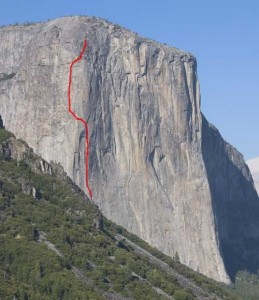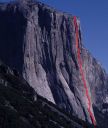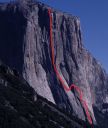El Capitan’s West Buttress
Layton Kor
AAJ 1964 p79
http://www.americanalpineclub.org/AAJO/pdfs/1964/79_Kor_ElCapitanWestButt_aaj1964.pdf#search=%22Yosemite%22
THE SPRING of 1963 seemed almost unreasonable: storm after storm kept the Valley walls plastered and the climbers grounded. As the bad weather continued, our patience began to fade. Finally Eric Beck and I decided to carry out our plans, come what may. Early one late-April morning we carried heavy packs, largely technical gear to the west side of El Capitan and after an hour arrived at the base of the 2000-foot West Buttress. Ropes, pitons, slings, hammers, all would play an important part in the siege climbing to follow.
A steep slab split by a diagonal crack began the ascent, and we marveled at the enjoyable free climbing. Two hundred feet up, the angle changed. As we had expected, we were soon in slings, placing one piton after another. On the third lead we ascended some sharp flakes and 50 feet higher placed three expansion bolts. From there a 30-foot pendulum took us left to another crack system. More delicate direct-aid climbing followed and soon we were on our first ledge of the climb. With a bolt on the blank wall behind, our belay was secure. One more aid lead up the dirt-filled crack above ended the day’s climbing. Soon we were on our way rappelling down the fixed ropes we had neatly left behind us.
After a rest day we returned to the climb, ready for anything except the weather, which suddenly sent us scurrying down our fixed ropes to the safety of the ground. This pattern of events became hopelessly monotonous, but an occasional new lead between stretches of bad weather pushed our ropes higher and higher. We both agreed that prusiking back up and rappelling back down the old fixed ropes was more nerve-racking than the climbing, which in many cases had reached extremes. At the 700-foot level we encountered some very strenuous climbing. Overhanging, flared bong-bong cracks with belays in slings left us dog-tired. Another day’s work put an end to this section, and with it came a definite change in the weather.
I had a bad shock when Eric informed me that he was unable to finish the climb. Several days later I joined forces with Steve Roper and we spent the next day fixing ropes to the 1200-foot level. One of us took a 15-foot fall here when an expansion bolt sheared off. Since we were running out of rope, we decided to call a halt to rope-fixing at this point.
We put several rest days to good use with the binoculars, as we wanted to insure ourselves of a feasible route above our fixed ropes. At five A.M. of May 18, the final push began. The hauling bags weighed us down as we prusiked up the lines before leaving their security and beginning the difficult “horizontal” traverse to the left. Pitons, many in upside down and some in only a finger’s width, constituted our ladder. After hours of ticklish direct aid, we had climbed 200 feet but not gained an inch in vertical height. We spied a small “white terrace” 140 feet below us and rappelled down for our first bivouac. Early the next morning we continued on typical Yosemite climbing; smooth, slanting overhangs, shallow cracks, all creating problems, took us a large part of the day and several hundred feet higher. Here was a broken area, which promised a place to spend the night, but since several hours of light remained, we climbed two more leads, anchored our ropes and returned to the ledge of our second bivouac at 1450 feet. Steve spent the night on a sloping ledge with his feet in the hauling bag while I lay flat in the corner. We amused ourselves with a harmonica until weariness sent us into a deep sleep.
This third morning we repacked our hauling bag and prusiked back up the ropes left from the day before. We felt small at the sight of the 500 feet (Gray Corner) rising above us. The long groove was a perfect drainage course for water; dirt filled the cracks and kept us moving at a slow pace. At nine o’clock we stepped onto a giant terrace, which ran horizontally for hundreds of feet in both directions. We walked unroped for fifty feet and then resumed roped climbing up the polished cracks above. When this vertical pitch ended at the base of the summit slabs, we knew the main problems were below us. Two leads of slab climbing took us to easy terrain. We rested a bit, shouldered our loads and hiked to the summit of El Capitan and the end of a marvelous climb.
All told, we spent seven and a half days on the climb, five of them to fix ropes to the 1200-foot level. We used 21 expansion bolts and about 200 pitons. The climb rates as Grade VI.
Summary of Statistics
AREA: Yosemite Valley
ASCENT: West Buttress of El Capitan, summit reached on May 20, 1963
(Kor, Roper) - first ascent.
PERSONNEL: Eric Beck, Layton Kor, Steven Roper




